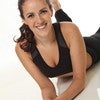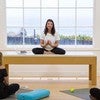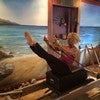Description
About This Video
Transcript
Read Full Transcript
I wanted to share some lovely variations that can be done on the ladder barrel. I absolutely adore this piece of equipment and sprinkling it into any workout is something that I've never met. A person who didn't enjoy, so starting out just the back bend over the barrel, stretching out. Some people can't get all the way to the bar most, but some can and you can have them up on a pedal if if they can't get this far. It's a wonderful way to start opening up the hip flexors, opening up the back and especially opening up the shoulders. Most people are very tight with the shoulders and then working down. Depending upon the length of the hamstrings, the feet can be further out or closer in and using the bar, the knees can be bent, but really using the arms to help stretch in and trying to keep the hands here to roll back up again, rolling back this time perhaps going lower so the stretch is deeper depending on the flexibility of the person. Again, three circles with the legs if they're up to that level.
This is definitely more advanced, lengthening down, hands to the waist, articulating through the waist, through this spine. Feet come together, the closer into the bar, the more the challenge and again walking down, hence they on the bar to read each challenge, the powerhouse and the flexibility in the spine rolling up last time, draping back and if possible going all the way to the back bar so the feet are way up in the air. Each angle opens and challenges the body in a new place and keeps releasing deeper and deeper into the body when it's ready for Nice and love rolling through the spine, rolling down. Nice, good stretch through the hamstrings, through the spine and rolling back up. Next variation is to open up the side body, so that was really increasing flexibility of the spine and stretching the front body. Now it's opening up the sidebar in working into the obliques, making sure from hip to waist is a nice length. Hands go in the middle and usually taking the bottom leg down and lengthening three times with the upper leg to get length or you can lift and lower both legs. At the same time coming down, usually a huge opening for people. Again, the side body is often way under challenged, so with the foot goes down, this is a great way to get into this outer hip area and length of the femur in the socket. We're working both legs at the same time.
It's also huge opening into the shoulders. Again, an area it most everybody lifestyle modern lifestyle is very droopy and then opening up into the sacrum and the lower back. Just lengthening out, allowing the spine to relax, allowing this whole area to traction and release can be a huge way for people to decongest in the lower spine and release tension around the sacred and then coming back up. So fabulous stretches, very popular and now coming into doing short box up here, which is so much fun to do and lovely. You can place yourself either right in the center or just in front, depending upon the way your ladder barrel is shaped and working. You can work with the hands. Whoops, let me get this mic out of the way. Okay. Rolling back.
Nice place to get support in the back and work through the powerhouse at the same time. Many people find it easier than doing it on the long box, rolling back again and now adding a stretch which can be lovely and rolling up and there's always the option of working with this stick. Let me use a stick now because the stick really allows you visually to have a perception of whether you're uneven in some way. So rolling back again, keeping the sticky, even keeping the stick even on the way down are your hands reaching towards the floor evenly and encouraging this sense of even as in the body, grabbing the stick in the bar, sliding the hips back on, giving the body a nice stretch, very nice way to open up elongate and just get traction and lengths in the body. So long stretch just reaching up and out three times because the knees are bent at this different angle. It gives a whole other perspective to this work and again, I stretch forward sliding the hips back. If you cancel the legs straight, coming up again, getting the hips right in the center and side bends. Nice.
Lift up through the spy, bending into one side, slight angle forward. So the waist is nicely contracting, the obliques are working. The other option is going for completely vertical plane, which has to do more with opening up the side body, opening up and stretching in the intercostal muscles between the inhale in the ribs. Again, nice stretch forward, nice length. The arms can pull the shoulders down the back to create more traction through the spine than going for the twist. So nice lift. The hipbones are very well anchored here, which gives such a lovely base to do this stretch and foundation for the work.
And then one more time lengthening even further through the spine. Very nice place to check that the knees don't go crooked so the hips stay grounded. So all the [inaudible] twist is coming in the trunk and is being held by the powerhouse. So great place to create stability and length at the same time. So next one is tree. I'm done with the stick.
So with the hips slightly forward lifting the knee, I like to work very deeply with knee into the chest in order to loosen up the hip socket. They similar to cingulate stretch. Of course, this depends upon the flexibility, but I'm less concerned with getting the knee straight just for the sake of stretching the leg. More concerned, even if the person is tight, is getting them working realistically to get this joint in airy nicely Luth after you've warmed up, lengthening up again and working the ankle, you can do ankle circles if you want to as well. Making sure that the foot on the par is really flexed well because that's your safety net for all of this, especially if you don't have a teacher holding your foot for you and then rolling down. Nice stretch, curling back up and lifting again, going down, articulating through the spine. I'm rolling back up and there's a fun super advanced variation I wanted to share with you right here. So this variation is really for the dancers or the gymnast who are the Super Flexible people or the daredevils who want to go for something fun and different. Walking down, making sure this back foot is nicely flexed and then sliding the hands to the floor. So if you're a teacher spotting this, you have to anchor the sport if they're short and they have to let go of that bar. Once the hands are stable, you go into a car, Cleo, and then you can go into the full splits, then forward little back bend, pull back up. And then from here if you can kick back up, anchor [inaudible], anchor that foot to come up and then bend over and have a nice stretch forward.
So for those that are ready for this, definitely be super advanced but fun to do when you get there. And just to run through the same thing on the other side, just doing the normal stretches, ankle stretches, rolling down, stretching out and giving my leg and my back a lovely stretch. And again, climbing down and climbing back up. And then for the superstar variation, going all the way down, hands come to the floor, making sure the hands are well anchored and the elbows a straight. That's kind of the secret cause everything else can be guided. If the elbows bend, you crash. If the elbows are straight, you're fine.
And the whole trick is to bring the hips forward. Spotting a student on this is helpful. Of course, nice split or poor working towards a split, pulling up again, placing the hands back, making sure the elbows a nice and straight. So you bring the shoulders towards the the barrel and then the barrel locks and catches you. Finding the bar, making sure the foot is well anchored and coming back up. When I stretch, securing that both hipbones and nice and even and giving your hips a lovely stretch forward. So that's when you want to be crazy and have fun. And then ballet stretches. Let me just get the stick out of the way.
Ballet stretches. Lovely. A grid to secure your standing in the middle. The leg presses over. So ideally the here lines up with the neighbor lines up with the sternum lines up with your nose. He always working this mid line of the leg, nice lift through the spine without the hips leaving, rolling down and rolling back up, lifting the chest, little back bend arking out and coming back up. Next variation.
Rolling down and lengthening out without the hips coming away from this back foundation. Big Lift of the sternum and opening up and back little back then and then reversing it, lifting the chest and extending with the long spine over the leg, pulling the powerhouse in and up to roll up, lifting the chest are coming back and coming back up. And then the same thing with the bent with the bent leg. So curling in, curling in and lengthening the spine out and arguing back and then reversing it. Long Spine and rolling back up, bringing the hips forward three times to get a lovely stretch in the hip flexor with the leg straight, sliding forward and back three times using the powerhouse, using the trunk, using the standing leg and then nice center on the standing night leg.
Nice flip through the body and if you can lifting the leg through time three times, and if you can't, you think about lifting it, it makes the muscles work very much. It works. A quad, there's no way around lifting the leg high without the quads working side bend as much as possible, trying to get the legs as close to the side as possible. But these two hipbones facing the front and let even links with the spine. So there's some variations. You can work with the leg more forward and the hipbone square or you can lift a little higher on this hip socket and lift up through the spine. Once the leg is higher than really 45 degrees, 50 degrees.
It's almost impossible to have the hips super, Super Square, but there's benefit to opening up the inner line of the body from this angle. Big Lift up to the side body and bending over through the leg. Big Lift and arking the other way. The big trick when you bend over to keep the hip anchored and bend from your hip socket, not from your waist. So you get that extra length through the body and reverse one more time, lengthening out if you want to. If you opt to give, grabbing the foot and pulling your hip in.
It's fun if you're ready for that. And then bending over to one side and long and opposition. So the trick here, the hips are no longer balanced because of the ankle angle of the hips. You're working the knee out and the shoulder on the inside of the knee, so it feels a bit tight. But again, you're opening deeper layers in the body that get very tight and congested and whatever you can do, it's all good. And then sliding the hip in three times, sliding the legs straight three times
The leg will want to go wide, but that's the angle you're looking to achieve three times. Lifting leg up, bending the and now the hips come back a bit and some, depending upon the flexibility, the person can bend forward, stretch the leg a little bit and then bring the leg in. Some people are not ready for the back, straight leg position, thigh stretch. Everybody is ready for lifting the hips up, not letting the back arch if they're able to as much as possible, taking the hips back to the foot and forward and forward. Wonderful. Stretch into the quads, into the hip flexor. I'm bringing the foot down and here we go with the other side. So nice and long like spine stretch, not spine stretch forward. Yes, like spine stretch forward and the next variation. Rounding through lifting the power house, lengthening forward and coming up with a little back bend and reversing it.
Long chest rolling up and little back bend. And the same thing with the bent leg round spine and arc and curling in, lengthening the spine out and back in the third one, lengthening all the way out and up and back. And then um, three times the hips come forward and lengthening the leg out. Three lifts, lifts and lifts and working to the side, looking to get the hips squared, both hipbones facing as close to front as you can, the leg going right to the side and lifting up. Really important to get this length here. Very useful to open and find space in the body to go to the side and lengthening away. Same thing again, seeing if you can go a little bit deeper. The hips will rotate slightly inwards as you do this.
And in order to actually increase flexibility and range, you need to allow the body to move out of a concept of perfection and let it be functional and it actually opens up a lot of freedom. So hips are not balanced because the angle is too hot. Ex Acute, you could say as much as possible, the knee is pressed out, the shoulder is in again, lengthening over, lengthening away, lengthening over and away. One more time, lengthening over and way and again, pressing the hips in, pressing the hips in, pressing the hips in and then lifting and lifting. I'm trying to keep my head as tall as before the lift.
And then here we go. Rotation out I go, I'm making sure I'm externally rotated with a sigh. The hip has to lift a little bit, the heel rotates around. And my focus is to bring the shoulders, the ribs, and the waist. As much as I can parallel to the side of the room and the hips as much as I'm capable of. And here again, sliding back, bringing the hips as close to the front bar. Some people find it helpful to lift up so that they get that extra length in the front of the body and lift three times.
I'm gonna lift the leg, lift the leg. If the leg get an extra stretch by bending it in and pulling the foot in and sliding the foot down, making sure the standing foot is in the middle of the barrel. The hips are high, the Chester's high hips go back towards the foot. Hips press forward while I left my powerhouse. Hips go back, hips go forward, hips go back and hips go forward. Really great variation. Now working on side bends, there's a few different variations that can be had.
So the first one kneeling out great for beginners. The leg that's close to the bar is in the front and I'm lengthening out my waist lifting up. So side bends, lifting up and down. Again, this can be good for beginners or good for very tall people, very stiff people to start to work in the waist, work around the side of the of the stomach muscles and also learn to create length, not just crushed themselves in so other side. Placing. Woops, have to get this Mike out of the way. Hips have to be in the middle. And again I'm creating, I'm not just going down, I'm lengthening in the waist and then lowering and lifting my body. So my focus point is constantly on creating this lift of the powerhouse lift through the lower back, lift through the side body so that there is space as I go through the movement.
Then coming back and doing the more advanced version. This can be done with straight legs or it can be done with slightly bent legs depending upon the size of the barrel, the size of the body and the range of movement. I'm going to be working with slightly bent legs, making sure the hips are stacked and this top foot is extremely flex cause that's what's literally holding me in place, lengthening through the powerhouse and lifting up and going down. So I'm going to do six of these great oblique work. Guys love this because it makes them work really hard and they like to know that they're working hard and women like it too.
And here we are, Mike, out of the way, foot in place, hips square, I'm in the middle of the barrel and here we go again. As I'm doing this, I'm checking am I relaxed in my shoulders. I'm really throwing the focus of the work where it needs to be and then coming back down. So Swan is another lovely exercise. It can be done on the ladder, barrel and very basic version for stiffer people or um, people that are tall and maybe the latter barrel is just smaller one. Some lot of barrels can be adjusted, just lengthening and lifting up and coming back down.
So this is a wonderful place to start to build up the back muscles and start to learn to work the upper back by making sure the elbow stay wide, not just the lower back. So if the person, the student is having trouble really isolating, you can keep the movement small so they learn to get the rib cage doing the work, not just the upper body. And then full Swann, the feet aren't Pilati stance in the middle of the ladder barrel with the knees bent. Hips are in the middle of the ladder barrel. I always measure my placement and lengthening up, lifting to the ceiling and arguing back with the knees bent, coming almost parallel to the floor, stretching out to the legs, nice and straight, keeping the leg straight as long as I can. And reluctantly Belden bending to wa Wa wa the hands back. Then lifting to the ceiling, stretching in front of me and bending down. So if there was a wall behind, I'd be walking my hands down the wall.
But as this space, I'm just going to reach towards the ocean. So this one needs flow to allow for the bigness of the movement and literally the relaxation in the body. So it's not one that you do slowly. We actually breathe into it, which allows the back to actually relax and open out and go as, it's a funny thing with flexibility. There's a relaxation needed to allow the movement to open up. So grasshopper's variation of Swan and swan dive. Again, very, not too often done, but it's a variation of swan dive and you can do it here and it's a lovely variation. So anchoring the hips over the top of the barrel, lifting the legs up, bending the legs in towards the barracks and up, and then clapping to lower down. So it really works. The legs a lot work, solo aback and more advanced variation is working the head, the legs towards the head to really challenge the bend of the legs to come all the way from almost the rib cage, which is something that everybody including me can work on.
And then the last one usually spotted, usually done with a wall is handstands where you walk the hands down. If there was a teacher spotting me, I would have been placed my hands in the middle. But as I'm doing this solo, I'll keep my hands close to the edge so I can use the ladder barrel as a place to press up from and then lift. So here's where you work on the vertical plane, lifting up through the spine, lifting up through the powerhouse, and then lowering down. And then one more time at sea lengthening. Way, way up to the whole spine is worked up. This really lovely for advanced work to get the coordination and feel like you've done something valuable in life. So I hope you've enjoyed this.
Use Bits and pieces of it and have fun.
Comments
You need to be a subscriber to post a comment.
Please Log In or Create an Account to start your free trial.






















